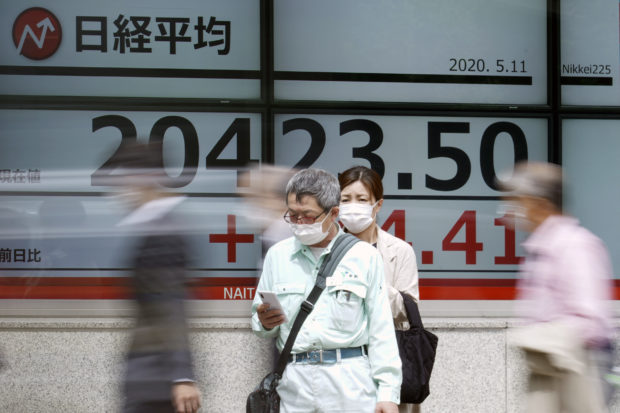TOKYO — Asian shares rose Tuesday, cheered by fresh moves by the U.S. Federal Reserve to support markets battered by the coronavirus pandemic.

A man wearing a face mask to help curb the spread of the coronavirus stands as others walk past an electronic stock board showing Japan’s Nikkei 225 index at a securities firm in Tokyo Monday, May 11, 2020. Shares advanced Monday, June 8, 2020 in Asia, buoyed by surprisingly strong U.S. jobs figures that helped power a surge on Wall Street on Friday. (AP Photo/Eugene Hoshiko)
Japan’s benchmark Nikkei 225 gained 3.2% to 22,212.62. South Korea’s Kospi gained 4.5% to 2,123.35, while Australia’s S&P/ASX 200 jumped 3.7% to 5,932.40. Hong Kong’s Hang Seng added 2.6% to 24,403.92. The Shanghai Composite edged up 0.9% to 2,916.07.
“In case the generosity of the Fed was in any doubt, it is not. Global equity markets are recovering quickly,” after the Fed announcement, Stephen Innes, chief global markets strategist at AxiCorp, said in a report.
Market players were also awaiting a Bank of Japan policy board meeting that ended Tuesday without a change to its minus 0.1% benchmark interest rate and ultra-lax monetary stance.
However, the central bank did expand its “Special Program,” including purchases of commercial paper and corporate bonds and its lending programs for commercial banks from 75 trillion yen to 110 trillion yen ($690 billion to $1.02 trillion).
In a statement, the Bank of Japan said the economy “is likely to remain in a severe situation for the time being due to the impact of COVID-19,” though it expects economic activity to resume gradually.
Overnight, the Fed’s move earlier brightened sentiment on Wall Street, which rallied back from a sharp, early slump on Monday to notch modest gains.
The Fed announced in the afternoon that it will buy individual corporate bonds. as part of its previously announced program to keep lending markets running smoothly and allow big employers to get access to cash.
The move was the latest reminder the Fed is doing everything it can to help support markets, analysts said. Central banks have repeatedly come to the economy’s rescue over the years, and it was huge, unprecedented moves by the Fed earlier this year that helped put a halt to the S&P 500’s nearly 34% sell-off on worries about the recession coming out of the coronavirus pandemic.
The S&P 500 rose 0.8% to 3,066.59, which is 9.4% below its record set in February.
The Dow Jones Industrial Average gained 0.6%, to finish at 25,763.16 after earlier falling as much as 762 points. The Nasdaq composite added 1.4% to 9,726.02.
“Volatility is here to stay, at least for a little while,” said Jason Pride, chief investment officer of private wealth at Glenmede. “Nobody in the financial industry has a good way to forecast this.”
Still, the number of COVID-19 cases is still growing in states across the country and nations around the world. Governments are relaxing lockdowns in hopes of nursing their devastated economies back to life, but without a vaccine, the reopenings could bring on further waves of COVID-19 deaths.
New York Gov. Andrew Cuomo, upset that big groups of people are packing together outside bars and restaurants without face masks, threatened Monday to reinstate closings in areas where local governments fail to enforce the rules.
That’s the biggest worry for markets: If infections swamp the world, governments could bring back the orders for people to stay at home and for businesses to shut down that sent the economy into its worst recession in decades. Even if that doesn’t happen, rolling waves of outbreaks could frighten businesses and consumers enough to keep them from spending and investing, which would itself hinder the economy.
“More importantly and something that seems to get lost in every rebound narrative is whether consumer behavior turns more cautious and inhibits a recovery in spending,” said Innes of AxiCorp.
Just a week ago, investors seemed ebullient with expectations for a recovery. Those hopes got a shot of adrenaline earlier this month when a report showed U.S. employers added jobs to their payrolls in May, a big surprise when economists were expecting to see millions more jobs lost.
That optimism sent the stock market on a second leg of its rally, which began in March after the Federal Reserve and Congress promised unprecedented amounts of aid to support the economy. Besides its corporate bond buying program, the Fed has also cut interest rates back to nearly zero and expects to keep them there through 2022. Its chair, Jerome Powell, may offer more details about the Fed’s outlook in scheduled testimony before Congress this week.
Benchmark U.S. crude lost 47 cents to $36.65 a barrel. It rose 86 cents to $37.12 a barrel on Monday. Brent crude, the international standard, fell 48 cents to $39.24 a barrel.
The dollar rose to 107.55 Japanese yen from 107.38 yen on Monday. The euro cost $1.1343, up from $1.1322.